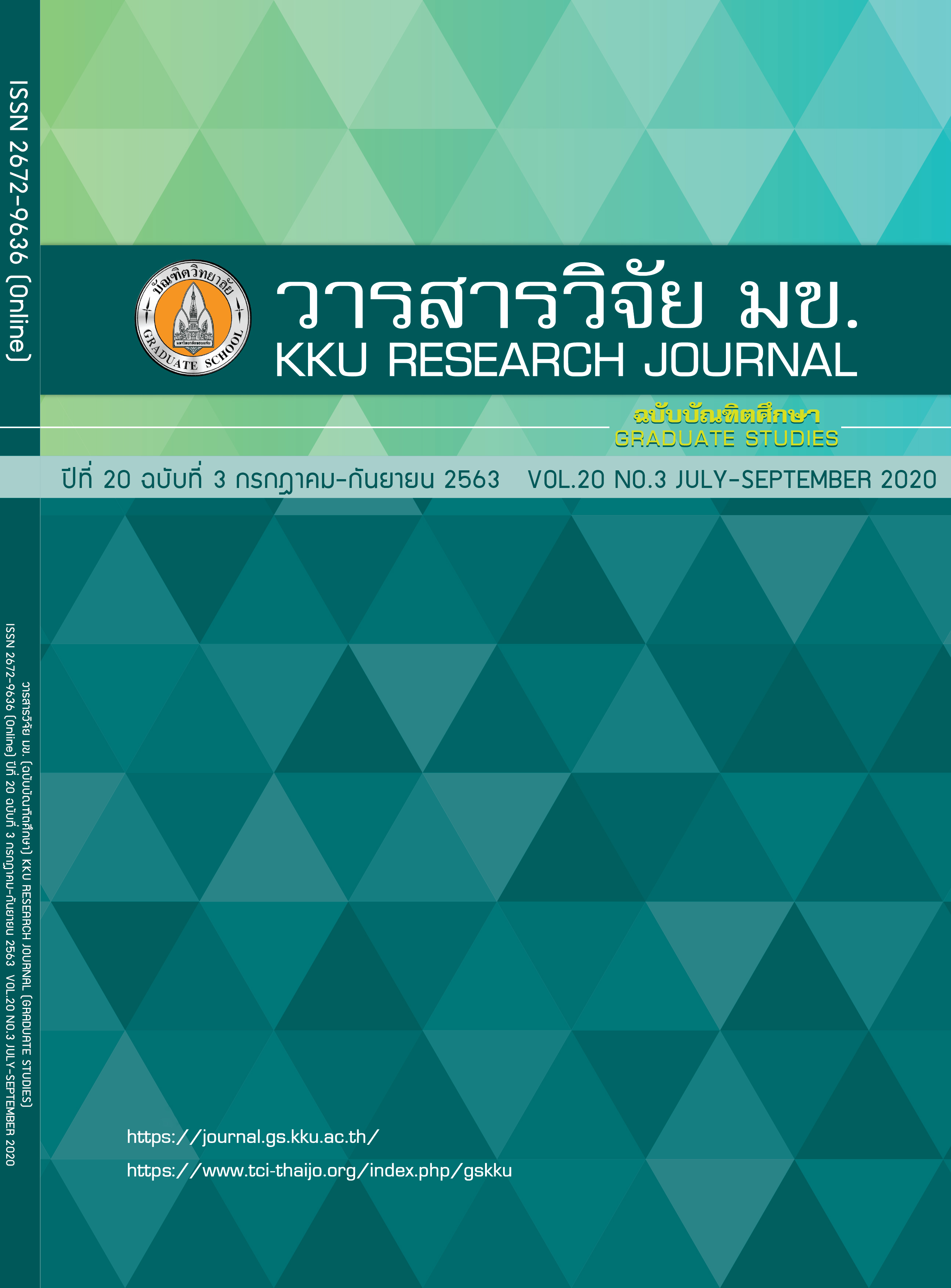แผ่นกรองเส้นใยผักตบชวาโดยใช้น้ำยางพาราธรรมชาติเป็นตัวประสานเพื่อบำบัดสีย้อมรีแอคทีฟในสารละลาย
คำสำคัญ:
เส้นใยผักตบชวา, สีย้อมรีแอคทีฟ, น้ำยางพาราธรรมชาติบทคัดย่อ
งานวิจัยนี้เป็นการศึกษาความเป็นไปได้ของการใช้แผ่นกรองจากเส้นใยผักตบชวาโดยใช้น้ำยางพาราธรรมชาติเป็นตัวประสานเพื่อบำบัดสีย้อมรีแอคทีฟ 3 ชนิด (2% Red, SBN, 2% Blue G and 2% Yellow RN) เส้นใยผักตบชวาถูกปรับสภาพโดยสารละลายโซเดียมไฮดรอกไซด์ ทำการศึกษาระยะเวลาสัมผัสพบว่า ระยะเวลาสัมผัสที่เหมาะสมคือ 3 วัน นอกจากนี้ค่าความจุในการดูดซับสีย้อมรีแอคทีฟทั้ง 3 ชนิด เท่ากับ 1.14, 1.20 และ 1.51 มิลลิกรัมต่อกรัม ตามลำดับ ที่ความเข้มข้นของสารละลายสีย้อมรีแอคทีฟทั้ง 3 ชนิด 20,10 และ 10 มิลลิกรัมต่อลิตร ตามลำดับ และเส้นใยผักตบชวา 1 กรัม ค่าสีของสารละลายที่ผ่านการบำบัดมีค่าไม่เกิน 300 ADMI (ค่ามาตรฐานน้ำทิ้งอุตสาหกรรม) อัตราส่วนโดยน้ำหนักที่เหมาะสมของเส้นใยผักตบชวาต่อน้ำยางพาราธรรมชาติคือ 1: 2 นอกจากนี้ทำการศึกษาประสิทธิภาพการกำจัดสีย้อมของแผ่นกรองเส้นใยผักตบชวาในสารละลายสีย้อมผสมทั้ง 3 ชนิด ผลการทดลองพบว่าแผ่นกรองเส้นใยผักตบชวาขนาด 5x16 เซนติเมตร สามารถกำจัดสีย้อมรีแอคทีฟทั้ง 3 ชนิด เมื่อผ่านสารละลายสีย้อมผสมเข้มข้น 10 มิลลิกรัมต่อลิตร ปริมาตร 640 มิลลิลิตร ดังนั้นแผ่นกรองเส้นใยผักตบชวานี้มีศักยภาพเพียงพอที่จะกำจัดสีย้อมรีแอคทีฟทั้ง 3 ชนิดนี้
References
Thiravetyan P, Towprayoon S, Inthorn D, Chawakitchareon P, Turakji P. Decolorisation of reactive dyes from textile dyeing wastewater by agricultural and industrial wastes [Internet]. 2006 [update 2014 May 23; cited 2019 Jan 23]. Available from: https://www.kmutt.ac.th/rippc/pmt43.htm
Ministry of industry. Guidelines for the management of waste water from textile dyeing factories. Bangkok: Chula Unisearch Chulalongkorn University; 2013. Thai.
Sarakarnkosol W. Pollution and danger of waste water from dyeing. Environmental Journal. 2017; 21(1): 7-14. Thai
Jiangbin Z, Zhengdong Z, Ru R, Xiaofeng S, Zhiping M, Hong X, et al. Chitosan adsorbent reinforced with citric acid modified β-cyclodextrin for highly efficient removal of dyes from reactive dyeing effluents. Eur Polym J. 2018; 108: 212-218.
Junlaoun J. Preparation of water hyacinth adsorbent for removal of direct dyes from textile wastewater [MSc thesis]. Bangkok: Kasetsart University; 2007. Thai.
Narawong W, Panya P, editors. Preparation of cellulose from water hyacinth leave to adsorb Cr (VI) ion. Proceedings of the 4th National Conference KPRU; 2017 Dec 22; Kamphaengphet, Thailand. Bangkok: Office of Academic Resources and Information Technology KPRU; 2018. Thai.
Ruparseart P. The utilization of water hyacinth stem bioadsorbent as growing material in constructed
wetland systems for dyestuff removal [MSc thesis]. Bangkok: Kasetsart University; 2015. Thai.
Jankat A, Auhachuk T, Songtumlee P, Aujitchai V, editors. Study of wood polymer composites from water hyacinth fibers and low density polyethylene (LDPE) using PE-g-MA as a compatibilizer. Proceedings of Forcons; 2015 Sep 18-20; Bangkok, Thailand. Bangkok: Ministry of Natural Resources and Environment; 2016. Thai.
Piriyayon S, Surin P, Buasri K, editors. The study of compressed fibers plates from a mixture of pennisetum pedicellatum with natural rubber latex. Proceedings of the 1st National Conference RUSCON; 2016 Jun 22; Ayutthaya, Thailand. Bangkok: Rajamangala University of Technology Suvarnabhumi; 2017. Thai.


